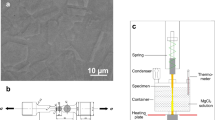Abstract
THE martensite reaction in steels has been studied by microscopic examination of polished and etched samples after the samples have been tempered for short periods of time. One etching reagent which has been used is a solution of 6 per cent nitric acid in alcohol, which is called 6 per cent nital. This etchant stains the martensite grey or black and leaves the austenite white.
This is a preview of subscription content, access via your institution
Access options
Subscribe to this journal
Receive 51 print issues and online access
$199.00 per year
only $3.90 per issue
Buy this article
- Purchase on Springer Link
- Instant access to full article PDF
Prices may be subject to local taxes which are calculated during checkout
Similar content being viewed by others
References
Cohen, J. B., Hurlich, A., and Johnson, M., Trans. Amer. Soc. Met., 39, 109 (1947).
Averbach, B. L., Sc.D. Thesis, Department of Metallurgy, Massachusetts Institute of Technology (September 1947).
Howard, R. T., and Cohen, M., Amer. Inst. Met. Eng., Tech. Pub. No. 2215, Metals Technology (August 1947).
Author information
Authors and Affiliations
Rights and permissions
About this article
Cite this article
HARRIS, W. Comparison of Metallographic and X-Ray Measurements of Retained Austenite. Nature 161, 315–316 (1948). https://doi.org/10.1038/161315b0
Issue Date:
DOI: https://doi.org/10.1038/161315b0
Comments
By submitting a comment you agree to abide by our Terms and Community Guidelines. If you find something abusive or that does not comply with our terms or guidelines please flag it as inappropriate.



